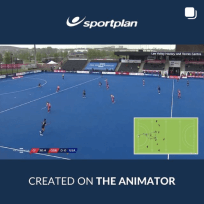
Groups of 5. Coach or players use cones (or throwdowns) to mark out a box with a cone in the middle. Each player stands on a cone. Pass in a n a "W" or zig-zag shape, i.e. player 1 passes to player 2, and so on, all the way around back to 1. Discourage losing the ball: Each group has [3] balls. Every time a group loses all their balls, they must do a forfeit, i.e. run once around the pitch / 5 push-ups before collecting them. Variation: Group of 6: 6th player stands at cone 6. Pass from 1>6 and back to 1. Group of 4 or 3: form a square or triangle respectively. Progression: Mixed abilities: Confident groups can pass multiple balls at same time. Challenge: 1 group must pass their 4 balls once around the W in the time it takes 1-2 other players to run(or dribble) around the W. Otherwise, the group must run a lap.
This activity involves short passing and receiving in a fast, continuous and mechanical cycle, with the aim of improving accuracy, ball speed, body position, footwork. Notes: Nobody should be waiting 20 seconds for a pass, there should be enough balls in play to keep everyone working constantly. Encourage players to start slow, using only 1 or 2 balls. Accuracy is more important than speed - there should be some kind of penalty to discourage wayward passing/mis-receives. Q: Passes should be to the forehand. Why? (Passes to the reverse stick are more likely to result in mis-receives.)
This practice has no coaching points
This practice has no progressions

in more ways than one




How did the Modern Olympics originally begin and why are they so culturally significant today?

The Professionalisation of Netball is changing the game. Here is how it is helping to develop the sport.

Scoring more goals is often the key to victory in netball. Here's how Sportplan can help you achieve this.